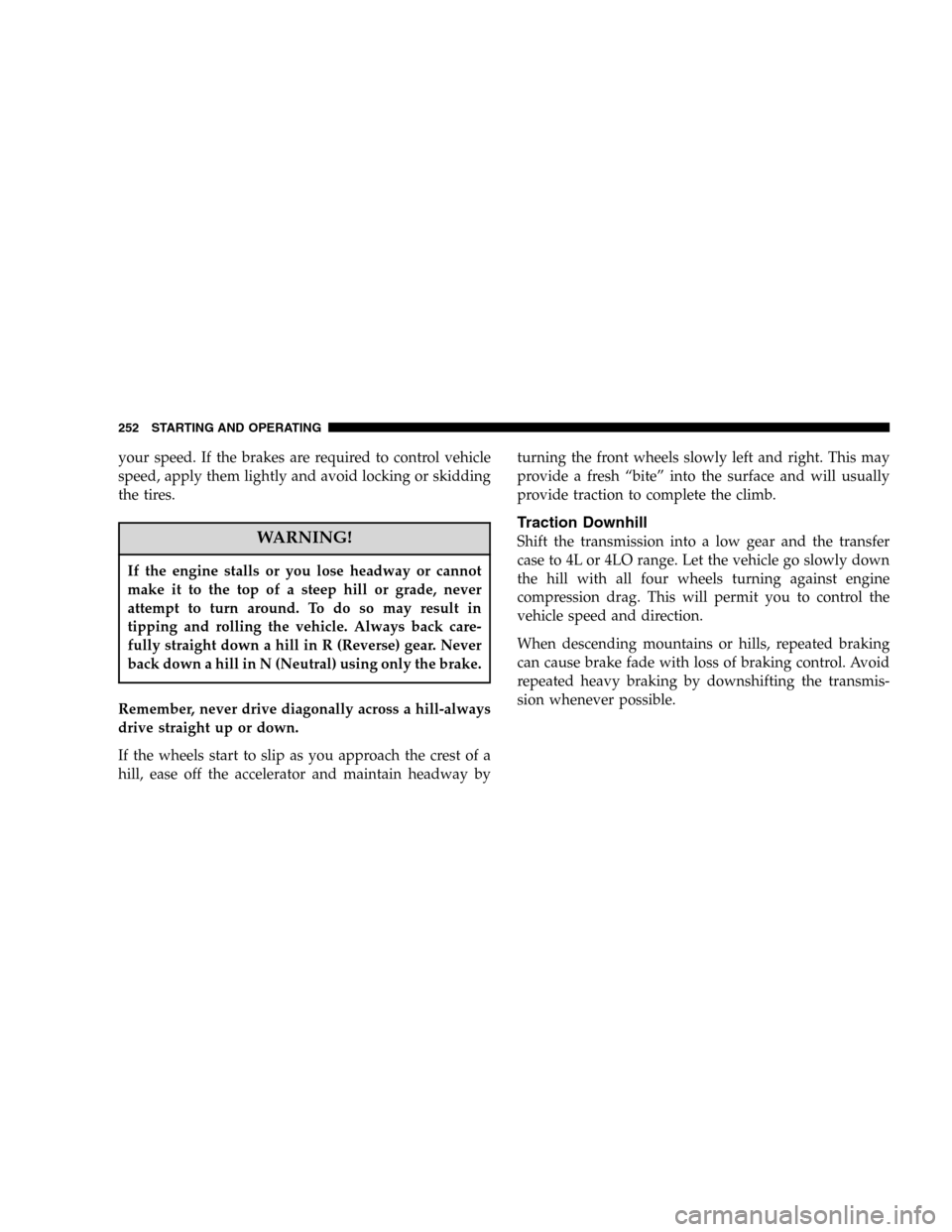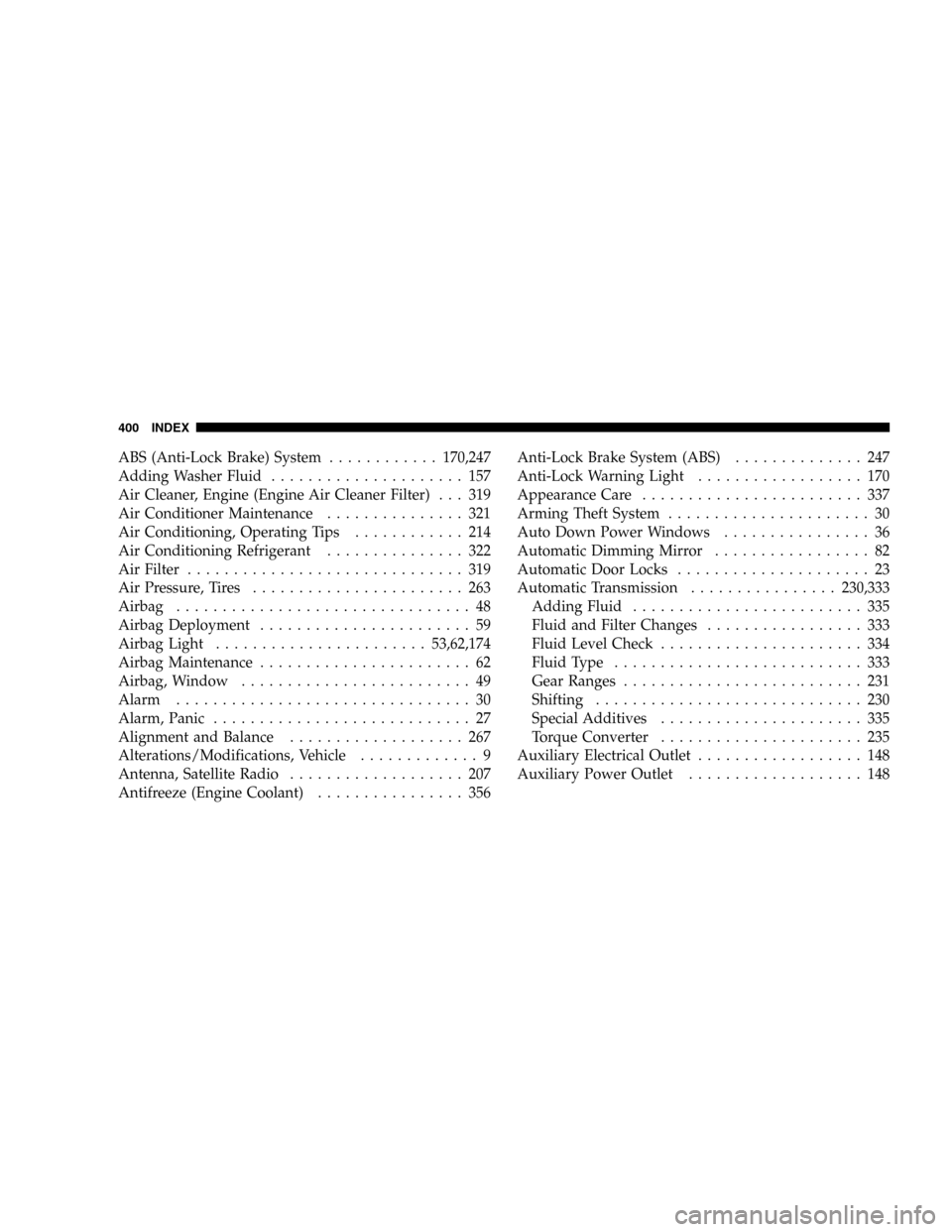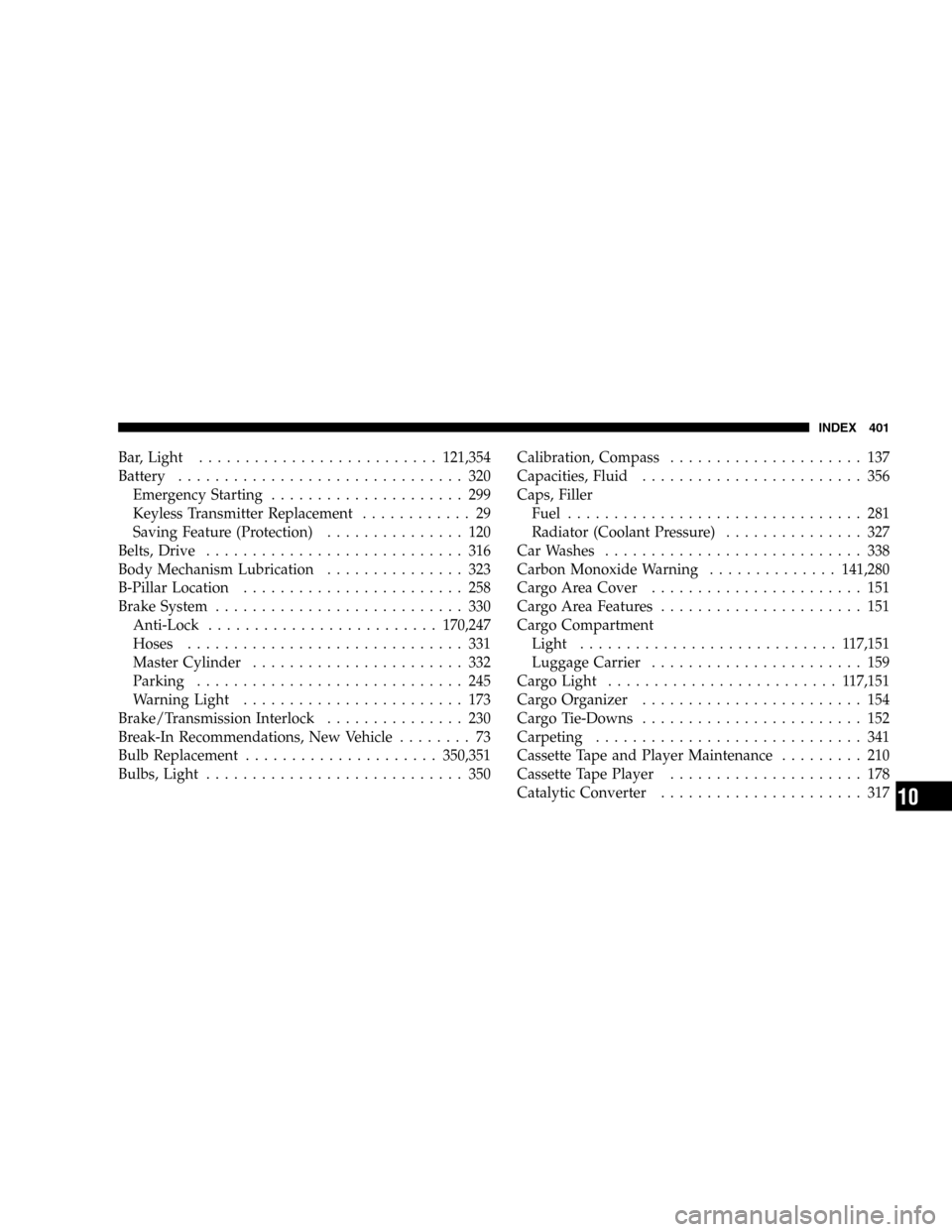Page 252 of 424

your speed. If the brakes are required to control vehicle
speed, apply them lightly and avoid locking or skidding
the tires.
WARNING!
If the engine stalls or you lose headway or cannot
make it to the top of a steep hill or grade, never
attempt to turn around. To do so may result in
tipping and rolling the vehicle. Always back care-
fully straight down a hill in R (Reverse) gear. Never
back down a hill in N (Neutral) using only the brake.
Remember, never drive diagonally across a hill-always
drive straight up or down.
If the wheels start to slip as you approach the crest of a
hill, ease off the accelerator and maintain headway byturning the front wheels slowly left and right. This may
provide a fresh “bite” into the surface and will usually
provide traction to complete the climb.
Traction Downhill
Shift the transmission into a low gear and the transfer
case to 4L or 4LO range. Let the vehicle go slowly down
the hill with all four wheels turning against engine
compression drag. This will permit you to control the
vehicle speed and direction.
When descending mountains or hills, repeated braking
can cause brake fade with loss of braking control. Avoid
repeated heavy braking by downshifting the transmis-
sion whenever possible.
252 STARTING AND OPERATING
Page 285 of 424
CAUTION!
If the trailer weighs more than 1,000 lbs (454 kg)
loaded, it should have its own brakes and they
should be of adequate capacity. Failure to do this
could lead to accelerated brake lining wear, higher
brake pedal effort, and longer stopping distances.
WARNING!
Connecting trailer brakes to your vehicle’s hydraulic
brake lines can overload your brake system and
cause it to fail. You might not have brakes when you
need them and could have an accident.
•Whenever you pull a trailer, regardless of the trailer
size, stop lights and turn signals on the trailer are
mandatory for motoring safety.
•Follow the maintenance intervals in schedule “B” for
changing the automatic transmission fluid and filter, if
you REGULARLY tow a trailer for more than 45
minutes of continuous operation.
STARTING AND OPERATING 285
5
Page 299 of 424

JUMP STARTING PROCEDURE
NOTE:Check the charge indicator on the battery. If the
indicator is light or yellow, replace the battery.
1. Wear eye protection and remove any metal jewelry
such as watch bands or bracelets that might make an
unintended electrical contact.
2. When boost is provided by a battery in another
vehicle, park that vehicle within booster cable reach but
without letting the vehicles touch. Set the parking brake,
place the automatic transmission in P (Park), or manual
transmission in N (Neutral), and turn the ignition to OFF
for both vehicles.
3. Turn off the heater, radio and all unnecessary electrical
loads.4. Connect one end of a jumper cable to the positive
terminal of the discharged battery. Connect the other end
of the same cable to the positive terminal of the booster
battery.
5. Connect the other cable, first to the negative terminal
of the booster battery and then connect the other end to
a non-paint metal surface on the engine of the vehicle
with the discharged battery. Make sure you have a good
contact on the engine.
6. Start the engine in the vehicle which has the booster
battery, let the engine idle a few minutes, then start the
engine in the vehicle with the discharged battery.
7. When removing the jumper cables, reverse the above
sequence exactly. Be careful of the moving belts and fan.
WHAT TO DO IN EMERGENCIES 299
6
Page 332 of 424
WARNING!
Worn brake hoses can burst and cause brake failure.
You could have an accident. If you see any signs of
cracking, scuffing, or worn spots, have the brake
hoses replaced immediately.
Brake Master Cylinder
The fluid level in the master cylinder should be checked
when performing under hood services, or immediately if
the “Brake Warning Light” shows system failure.
Be sure to clean the top of the master cylinder area before
removing the cap. If necessary, add fluid to bring the
fluid level up to the requirements described on the brake
fluid reservoir. With disc brakes, fluid level can be
expected to fall as the brake pads wear. However, low
fluid level may be caused by a leak and a checkup may be
needed.
332 MAINTAINING YOUR VEHICLE
Page 362 of 424

At Each Stop for Fuel
•Check the engine oil level about 5 minutes after a fully
warmed engine is shut off. Checking the oil level while
the vehicle is on level ground will improve the accu-
racy of the oil level reading. Add oil only when the
level is at or below the ADD or MIN mark.
•Check the windshield washer solvent, add as required.
Once a Month
•Check the tire pressure and look for unusual wear or
damage.
•Inspect the battery, and clean and tighten the terminals
as required.
•Check the fluid levels of the engine coolant/anti-
freeze reservoir, brake master cylinder, and transmis-
sion, and add as needed.
•Check all lights and all other electrical items for correct
operation.
At Each Oil Change
•Change the engine oil filter.
•Inspect the exhaust system.
•Inspect brake hoses.
•Check the engine coolant/anti-freeze level, hoses, and
clamps.
•Inspect manual transmission fluid level, and for leaks
(if equipped).
•After completion of off-road operation, the underside
of the vehicle should be thoroughly inspected. Exam-
ine threaded fasteners for looseness.
362 MAINTENANCE SCHEDULES
8
M
A
I
N
T
E
N
A
N
C
E
S
C
H
E
D
U
L
E
S
Page 379 of 424

At Each Stop for Fuel
•Check the engine oil level about 5 minutes after a fully
warmed engine is shut off. Checking the oil level while
the vehicle is on level ground will improve the accu-
racy of the oil level reading. Add oil only when the
level is at or below the ADD or MIN mark.
•Check the windshield washer solvent, add as required.
Once a Month
•Check the tire pressure and look for unusual wear or
damage.
•Inspect the battery, clean and tighten the terminals as
required.
•Check the fluid levels of engine coolant/anti-freeze
deaeration bottle, brake master cylinder, and transmis-
sion, and add as needed.
•Check all lights and all other electrical items for correct
operation.
At Each Oil Change
•Change the engine oil filter.
•Inspect the exhaust system.
•Inspect brake hoses.
•Check the engine coolant/anti-freeze level, hoses, and
clamps.
•Inspect engine accessory drive belts. Replace as neces-
sary.
•Inspect for the presence of water in the fuel filter/
water separator unit.
Tire Rotation
•Rotate the tires every 6,000 miles (10 000 km).
SCHEDULE “A” — GASOLINE ENGINES 379
8
M
A
I
N
T
E
N
A
N
C
E
S
C
H
E
D
U
L
E
S
Page 400 of 424

ABS (Anti-Lock Brake) System............170,247
Adding Washer Fluid..................... 157
Air Cleaner, Engine (Engine Air Cleaner Filter) . . . 319
Air Conditioner Maintenance............... 321
Air Conditioning, Operating Tips............ 214
Air Conditioning Refrigerant............... 322
Air Filter.............................. 319
Air Pressure, Tires....................... 263
Airbag................................ 48
Airbag Deployment....................... 59
Airbag Light.......................53,62,174
Airbag Maintenance....................... 62
Airbag, Window......................... 49
Alarm................................ 30
Alarm, Panic............................ 27
Alignment and Balance................... 267
Alterations/Modifications, Vehicle............. 9
Antenna, Satellite Radio................... 207
Antifreeze (Engine Coolant)................ 356Anti-Lock Brake System (ABS).............. 247
Anti-Lock Warning Light.................. 170
Appearance Care........................ 337
Arming Theft System...................... 30
Auto Down Power Windows................ 36
Automatic Dimming Mirror................. 82
Automatic Door Locks..................... 23
Automatic Transmission................230,333
Adding Fluid......................... 335
Fluid and Filter Changes................. 333
Fluid Level Check...................... 334
Fluid Type........................... 333
Gear Ranges.......................... 231
Shifting............................. 230
Special Additives...................... 335
Torque Converter...................... 235
Auxiliary Electrical Outlet.................. 148
Auxiliary Power Outlet................... 148
400 INDEX
Page 401 of 424

Bar, Light..........................121,354
Battery............................... 320
Emergency Starting..................... 299
Keyless Transmitter Replacement............ 29
Saving Feature (Protection)............... 120
Belts, Drive............................ 316
Body Mechanism Lubrication............... 323
B-Pillar Location........................ 258
Brake System........................... 330
Anti-Lock.........................170,247
Hoses.............................. 331
Master Cylinder....................... 332
Parking............................. 245
Warning Light........................ 173
Brake/Transmission Interlock............... 230
Break-In Recommendations, New Vehicle........ 73
Bulb Replacement.....................350,351
Bulbs, Light............................ 350Calibration, Compass..................... 137
Capacities, Fluid........................ 356
Caps, Filler
Fuel................................ 281
Radiator (Coolant Pressure)............... 327
Car Washes............................ 338
Carbon Monoxide Warning..............141,280
Cargo Area Cover....................... 151
Cargo Area Features...................... 151
Cargo Compartment
Light............................ 117,151
Luggage Carrier....................... 159
Cargo Light......................... 117,151
Cargo Organizer........................ 154
Cargo Tie-Downs........................ 152
Carpeting............................. 341
Cassette Tape and Player Maintenance......... 210
Cassette Tape Player..................... 178
Catalytic Converter...................... 317
INDEX 401
10